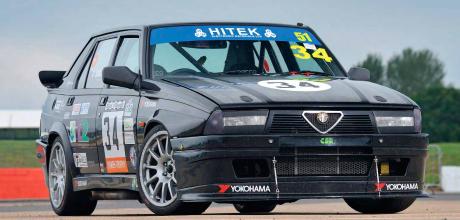1987 Alfa Romeo 75 3.2 V6 Racing Car - giant-killer on test
Oldie But Goodie Being competitive in a classic car in a race series intended for modern cars takes skill and clever preparation. We track-test George Osborne’s V6-powered 75 at Silverstone to find out how.
Story by Roberto Giordanelli. Photography by Michael Ward & Guy Swarbric.
ALFA ROMEO 75 V6
Giant-killing racer on test at Silverstone Racing 1987 Alfa-Romeo 75 V6:
Motor racing means ducking and diving, the confidence to change plans in an instant. With this comes racecraft, which is quite different to driving fast in a race or on a track day. The best cars to help with racecraft, as well as providing pleasure, are those that handle well and are capable of said ducking and diving.
“ CSR looked at the set-ups used by early Alfa 75 Touring Cars in the late 1980s and in particular the BTCC cars of Alfa Romeo Dealer Team ”
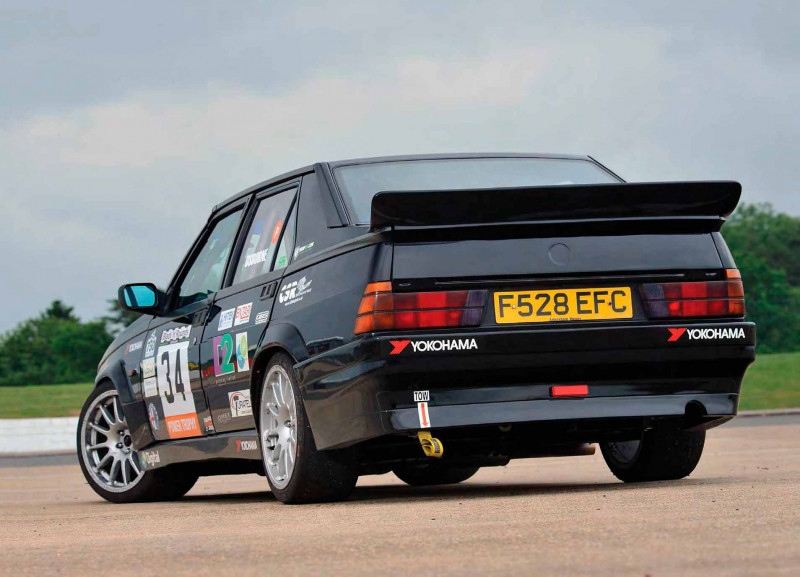
1987 Alfa Romeo 75 3.2 V6 Racing Car — giant-killer on test / F528 EFC UK-REG RHD
With this in mind, I’m wondering about the black beast lurking in the Silverstone pit garage. It is a common misconception to equate power and speed with fun and enjoyment. The faster you go on, the more fun you’ll have, right? Well, actually, no. It is far more complicated than that. Pleasure derives from the satisfaction that you are getting the best from yourself and your car, that the car you are racing can be pushed beyond the limit and still be saved. This enables the driver to race properly. The ultimate goal is winning – and George Osborne’s Alfa Romeo 75 V6 is certainly a winner.
George built his racer from a road car in a shed. He is a one-man band, one of a diminishing number of multiskilled individuals who can build a successful race car and know how to drive it. Constructing a racing Alfa Romeo is much more difficult than more mainstream cars that have a host of specialist companies ready with all the parts you need. With Alfa Romeos, you can’t simply place an order and the next day all the right kit will be on your doorstep. But things are better than they used to be. Today, tucked away near Goodwood Motor Circuit, there is a flourishing Alfa Romeo racing community. There’s Chris Snowdon (CSR Racing), who with Richard Melvin is now manufacturing specialist Alfa racing parts for global despatch. And just three miles away is another Alfa specialist, Alex Jupe Motorsport. Nip further along the south coast and you’ll find Peter Smart Classic Alfas.
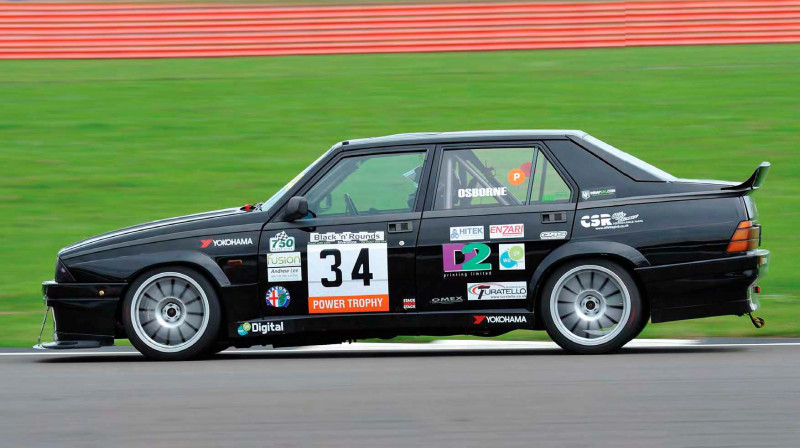
Chris Snowdon and Richard Melvin joined George to meet us at Silverstone to show us around this race-winning Alfa 75. Road-going Alfa 75s were manufactured from 1985 to 1992 as the last of Alfa’s rear-wheel drive saloons (until the current Giulia) and many have called the 75 the last real Alfa Romeo. Works racing Alfa 75s had either naturally aspirated 3.0-litre V6 engines or 1.8 four-cylinder turbos. The V6 cars were rather heavy. And while the turbo cars were lighter, they had reliability problems if run with high boost because the aluminium Alfa Nord twin cam block was not rigid enough for serious power. If braced with steel plates and scaffold poles, 300hp was OK but moving up to 500hp resulted in blow-ups, oil slicks, smoke and shrapnel.
George’s car has a pretty much stock 3.2-litre 24V V6 producing 220hp at the wheels. It weighs 1135kg, resulting in a power-to-weight ratio of 194hp per tonne. That means it can race in the Alfa Romeo series ARCA Power Trophy, which is open to Alfa Romeos, Fiats and Lancias running to a power-to-weight ratio of 195hp per tonne at the wheels (for non-turbo petrol cars) or 175hp per tonne (diesels and turbo cars).
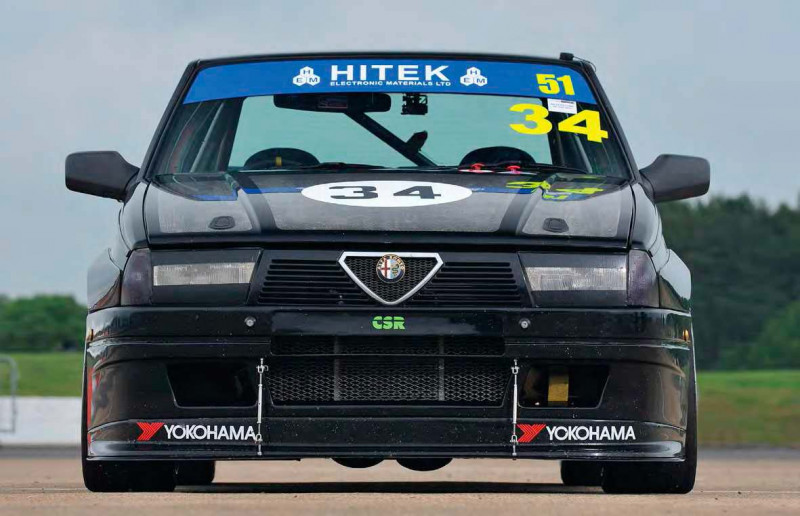
At the time of writing, George is leading the ARCA Power Trophy championship in a close battle with Tom Hill’s Alfa GT 3.2. The front-wheel drive versus rear-wheel drive battles always make for exciting dynamics. That a 30-year old car can be competitive in a modern championship like this is remarkable and we can only hope that George’s success will bring more older cars into the championship.
George and the team are currently planning to modify the car to move into historic racing. This would require a full-race 3.0 V6 12V engine, with power raised to 300hp. Losing some weight would also be advantageous, which could increase the power-to-weight ratio to 270hp per tonne. The 75 would then be eligible for the world’s most prestigious races for period Touring Cars, and organisers like Motor Racing Legends would also welcome it. A switch to historics would also add significantly to the car’s value and enable the car to race at the world’s best race circuits.
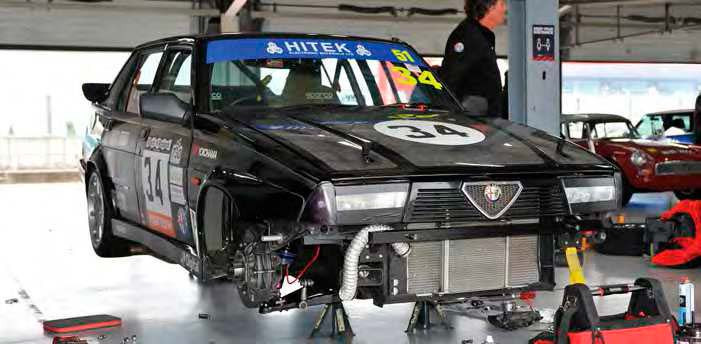
So what is the car’s current specification? The suspension is quite special, with everything upgraded by CSR, which helped to develop the suspension with George. In its early configuration, George went down the tubular route with front upper and lower wishbones, deleting the torsion bars and running a full coilover set-up with standard uprights, while the rear was left pretty standard. Several issues were identified, including spindle flex and a lack of front tyre temperature.
CSR looked at the set-ups used by early Alfa 75 Touring Cars in the late 1980s and in particular the BTCC cars of Alfa Romeo Dealer Team. These were a direct development of the previous season’s GTV 6 and initially the GTV 6 suspension was directly transplanted. This had shortcomings when transposed into the 75 but made a good starting point for George’s car. The biggest change up front was the use of an Alfa 6 upright, which has a much bigger spindle and inner bearing, and limits the flex caused by the larger loads of big brakes and wide slicks. Positive geometry changes were made by using the factory steel wishbones and mounting the uprights on top of the wishbones, plus a height-matched ball joint on the upper arm. The effect was a straighter lower wishbone and more rising rate camber when cornering.
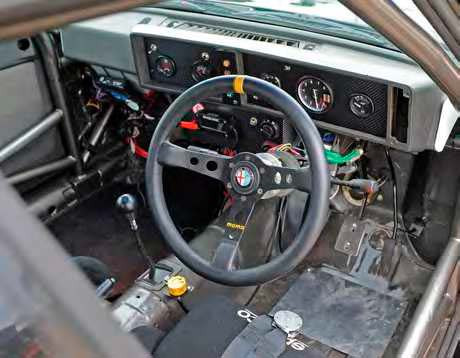
“I would love to say we developed it all using computer simulations,” says Richard Melvin, “but we actually copied the original front set-up from the Dealer Team Cars. Jon Dooley had given me the complete suspension kit from his 75 that had been removed from the car in 1987 and had been on a shelf waiting to be measured and reproduced. These are all stock parts at CSR now.”
The Quantum Racing dampers are bespoke to George’s car and a development of the QRS shocks that are sold by CSR as a kit. George is also running an ex-Dealer Team ‘Shankle’ rear anti-roll bar for the dry setting that also came from Jon Dooley. Yokohama 230/610 17 slicks are mounted on Team Dynamics 17x7 wheels.
Up front are AP front brakes, while the inboard rear brakes have their own cooling system. With inboard rear brakes, the transmission heats the brakes, and the brakes heat the transmission, so a cooler is essential. Aerodynamic aids include a deep front spoiler/splitter and a big boot spoiler.
The standard rear-mounted gearbox/transaxle on the 75 was just about acceptable for road use. For racing, it was the car’s Achilles heel. When manufacturers like Ferrari, Maserati and Porsche used a transaxle, they fitted a torque tube, a large chunk of steel that joins the front-mounted engine to the rear-mounted gearbox. The propshaft rotates at engine speed inside the torque tube but without such a tube, the engine and transaxle wobble about independently creating all sorts of shock loads. Think of it like a disorderly heavyweight boxing match with a tiny referee. The little ref is in the middle trying to control the heavyweights who won’t stop slugging it out.
Richard Melvin and CSR have special clutch housings, and countless more components for racing Alfas. An external steel cage to reinforce the clutch housing is an old trick to stop the housing from breaking. Whilst racing in the 1980s on Snetterton’s old Revett Straight, I witnessed Tim Stewart’s Alfa GTV 6 clutch and flywheel assembly slice through the floorpan and exit the car through a side window!

George’s car has been fitted with a CSR-supplied close-ratio non-synchro straight-tooth racing transmission. It runs an uprated limited slip diff and a new, uprated twin-plate clutch. The dog ’box runs homologated gear ratios that are pretty close-set: first is 2.57, second 1.94, third 1.55, fourth 1.22 and fifth 1.0. After some initial races, gearbox temperatures were getting very high so a gearbox oil cooler has been fitted to keep them under control, again sourced from CSR ( www.alfettagtv6.co.uk).
Time for our test drive at a superbly organised track day courtesy of Ed Moore’s Motorsport Events. It takes a couple of laps to warm the slick tyres enough to lean on them, and then maybe another lap or two before they are toasty enough to really push. By now, the transmission oil has warmed up enough to switch the pump on and send the oil through the rear cooler. The car is slightly front-heavy, which is OK: it means that if the tail steps out, it is easily caught. Corner exit traction is very good for a rear-drive car. The power band is wide, with up-changes at 6500rpm, or 7000rpm when racing. The gearshift on a 75 is never going to be perfect, but in this case, it is good enough thanks to the slack in the gear linkage being removed and the right spring loadings for the five-speed gate being used.
George has fitted electric power steering to the car, which may seem surprising. Many a time I have had disagreements with a co-driver about the appropriate effort to turn a steering wheel. Steering effort can be adjusted by changing the caster angle: more caster equals more weight. More caster also delivers more straight-line stability and useful camber gain as the steering angle increases. However, some cars can have minimal caster angle and still suffer from excessively heavy steering. I remember driving a works BMW Touring Car in South Africa that had impossibly heavy steering. Arriving at a corner, I took a deep breath and used all my strength to apply steering input. I had no idea what was happening at the tyre contact patch. This was an extreme case but is an example of how heavy steering can remove driver finesse. It can mean confusing steering weight with the tyre reaching its limit. With light steering, believe it or not, there is more feel – and George’s electric steering modification is a good one.
Time to push on. The track was busy with modern high-powered and lightweight modified cars circulating at speed. It quickly became obvious that George’s 35-year-old car was not only the oldest car on track but also the quickest. This meant much overtaking and, as you may know, there are strict rules at track days about overtaking. I never got anywhere near a clear lap, so no meaningful lap time was recorded. However, later in the day when track traffic reduced, Chris Snowdon managed a clear lap with a time that was good enough to deliver a race win.
The team asked me my thoughts on understeer in slow corners like the more-than-180-degree turn that is Luffield. They know that to dial out understeer at Luffield would induce excessive oversteer at Coppice and other fast corners. My solution was to change driving styles at each corner to suit the changes in handling characteristics. For example, at Luffield, I trailbraked into the turn, adding weight to the nose to eliminate understeer. Once into the U-shaped turn, I used a more V-shaped line to eliminate understeer on the way in and also give a straighter and faster exit from Luffield. This enables the car to carry more straight-line speed all the way to Coppice.
My conclusion is that this 75 is a user-friendly racing car that can be driven hard with impunity. By user-friendly, I mean user-friendly for racing. While this Alfa is almost capable of passing an MOT, it would be traumatic to drive on the road. Well done, George. Where would UK motorsport be without men in sheds? TOP: Lap Analysis via V-Box to finesse both chassis and driver. MID RIGHT: Alfa 6 Upright with Quantum coil-over, CSR upper ball joint and reversed ball joint lower arm.
TECHNICAL SPECIFICATIONS 1987 Alfa Romeo 75 3.2 V6 Racing Car
- ENGINE: 3179cc 24-valve V6
- BORE X STROKE: 93mm x 78mm
- FUEL SYSTEM: OMEX 710 management fuel and ignition
- MAX POWER: 220hp at 6800rpm (at the wheels)
- MAX TORQUE: 250lb ft at 5200rpm (est)
- TRANSMISSION: 5-speed close-ratio dog ’box, LSD
- SUSPENSION: Double wishbones, anti-roll bar and stabiliser (front) De Dion, anti-roll bar (rear)
- BRAKES: AP vented discs, 320mm (front), 260mm (rear)
- WEIGHT: 1135kg
- MAX SPEED: 138mph (est)
- 0-62MPH: 4.7sec (est)
ABOVE: George regularly dices with much more modern machinery in the ARCA Power Trophy – and has proven very competitive.
ABOVE RIGHT: Roberto getting stapped in.
BELOW: The gearbox has it’s own dedicated cooling. Steering has power assistance.
ABOVE LEFT: Roberto Giordanelli and George Osborne in pre-run discussion. ABOVE: Chris Snowdon checks tyre temps at Silverstone


